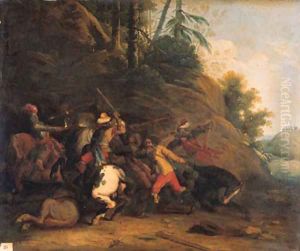Pieter Snayer Paintings
Pieter Snayer was a Flemish Baroque painter known for his detailed depictions of military scenes and battles from the Thirty Years' War and other conflicts of the 17th century. Born in Antwerp in 1592, Snayers became an apprentice to Sebastiaen Vrancx, who was also known for his battle scenes and landscapes. Vrancx's influence is evident in Snayer's work, which similarly captures the dynamism and tumult of warfare.
Snayers became a master in the Antwerp Guild of Saint Luke in 1612. His career flourished as he gained patronage from prominent figures of the time, including the Archduke Albert of Austria and the Cardinal-Infante Ferdinand of Spain. These connections helped Snayers secure commissions that would bring him fame and recognition.
Throughout his career, Snayers focused on the accuracy and detail of military attire and equipment, as well as the strategic aspects of the battles he portrayed. His paintings are characterized by their large scale and the vivid action they depict, often crowded with soldiers, horses, and the chaos of combat. Snayers' works were not just artistic triumphs but also served as historical documents of the warfare of his time.
Despite his focus on war, Snayers also produced a number of more serene landscapes, although these are less well-known compared to his battle scenes. His work was influential, and he had several pupils, including his stepson, the battle painter Peter Meulener.
Pieter Snayers died in Brussels in 1667. His art remains on display in several European museums, offering a window into the conflicts that shaped Europe in the 17th century.
